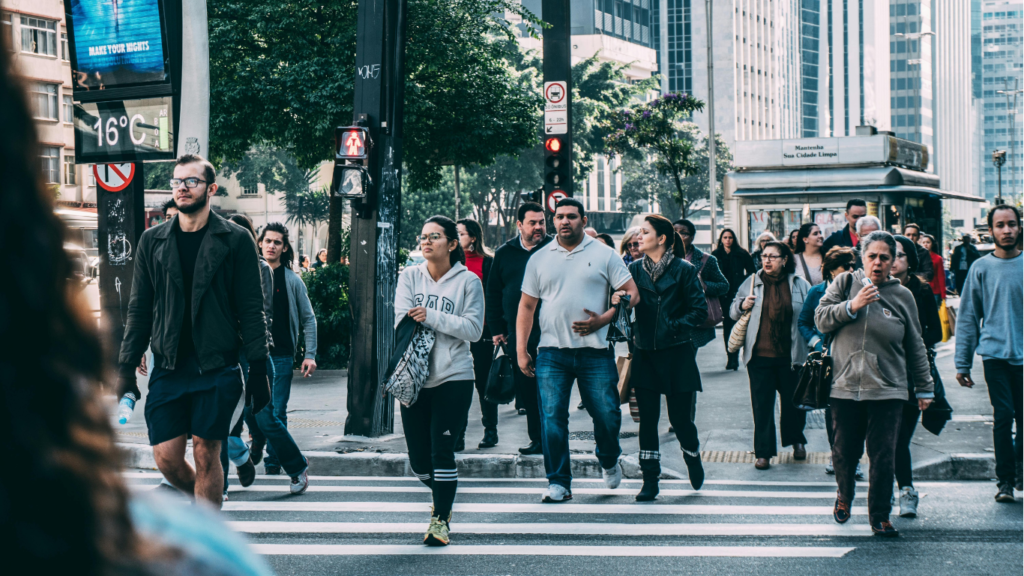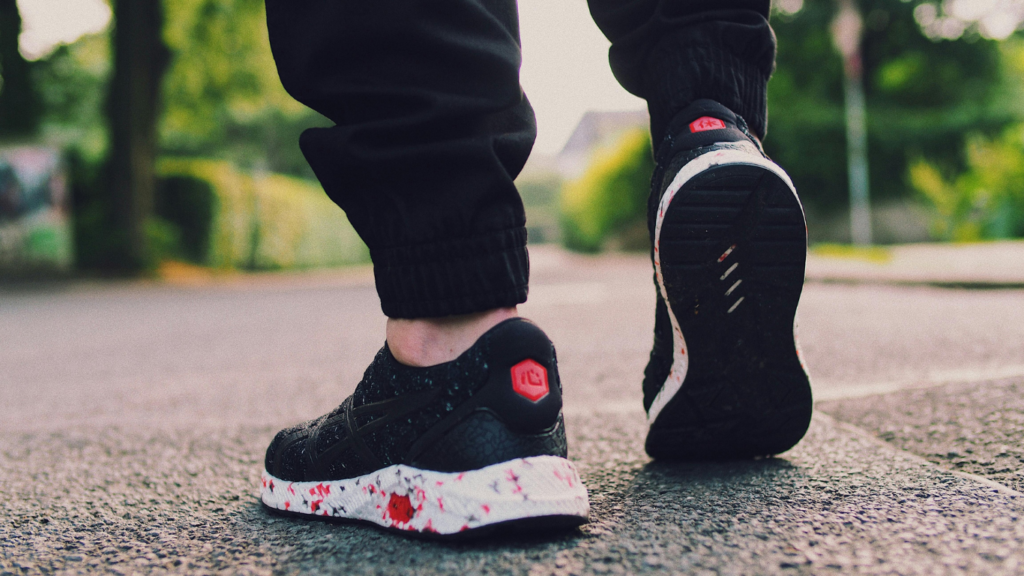
“5 or 6 kilometers—be honest, when was the last time you walked that far? If you can’t remember, you’re not alone! But guess what? Soon, you’ll be breezing through 7 to 8 km a day without breaking a sweat. Not convinced? Let me show you how easy it can be!”
Did You Know How Far 10,000 Steps Really Are?
Did you know that walking 10,000 steps equals roughly 7 to 8 kilometers? Here’s the math behind it:
➡️ The average stride length for most adults ranges between 0.75 meters (75 cm) to 0.8 meters (80 cm).
➡️ 10,000 steps × 0.75 meters = 7.5 km
➡️ 10,000 steps × 0.8 meters = 8 km
To put that into perspective:
✅ That’s like walking from one side of a small city to the other.
✅ It’s the equivalent of walking around 10 football fields or completing half a half-marathon.
✅ At a moderate walking pace of about 5 km/h, you could cover this distance in roughly 1.5 to 1.6 hours — but the beauty is, you don’t have to do it all at once!
Calories Burned from Walking 10,000 Steps
The number of calories burned while walking depends on factors like weight, walking speed, and intensity. Here’s a rough estimate:
| Weight | Calories Burned at Moderate Pace (5 km/h) | Calories Burned at Brisk Pace (6.5 km/h) |
| 50 kg | ~ 200–250 kcal | ~ 300–350 kcal |
| 60 kg | ~ 240–300 kcal | ~ 360–420 kcal |
| 70 kg | ~ 280–350 kcal | ~ 420–490 kcal |
| 80 kg | ~ 320–400 kcal | ~ 480–560 kcal |
Take the simplest steps to reach this goal effortlessly—start now!

🌅 Step Into a New Morning—Without Even Trying (~2,000 steps)
The alarm buzzes. You stretch, rub your eyes, and sit up. Instead of scrolling through your phone, you decide to stand up and walk around while brushing your teeth. Step one—done.
The coffee machine hums. While waiting, you pace around the kitchen instead of leaning against the counter. Step two—effortless.
Heading to work? Imagine this: Instead of squeezing into the closest parking spot, you pick one a little farther. A small shift, but suddenly, your morning steps are adding up.
By the time you settle into your desk or daily routine, you’ve already walked close to 2,000 steps—without a second thought.
👉 Why Walking is Essential After Waking Up in the Morning?
✅ Your brain wakes up before your emails do: Morning movement under natural light resets your body clock, keeping your energy levels steady.
✅ Momentum fuels the rest of your day: You’re already active before breakfast—making healthier choices easier.
The best part? You didn’t even “work out”—you just lived differently.

💼 Creative Ways to Get Your Steps In—Even with a Desk Job! (~4,000 steps)
The clock hits 11 AM. You’ve been glued to your chair for hours. Your back feels stiff, and your energy? Fading.
Instead of sending that email, you stand up and take a quick stroll to your colleague’s desk. Conversation flows better in person anyway.
A call comes in—do you stay seated? Not today. You grab your phone and pace around while talking. Suddenly, the meeting feels lighter, ideas come faster.
Lunchtime. The elevator doors open—but you walk past them. A few flights of stairs, a small win. Steps are adding up, and you barely noticed.
By the time your afternoon coffee kicks in, you’ve already moved 4,000 steps—without scheduling a single “workout.”
👉 Why Walking is Essential for Desk Job Professionals?
✅ Your stress levels drop before they peak: Moving between tasks helps reset your mind, keeping stress in check.
✅ Your focus sharpens effortlessly: That little boost in circulation? It’s feeding your brain, making your ideas sharper than ever.
And just like that, you’re moving more—without extra effort.

🏃♀️Workday Wins: How Simple Office Moves Can Boost Your Daily Steps (~1,500 steps)
The coffee machine beeps. You could stand there and scroll through your phone—or you could take a few steps around the kitchen. You choose the latter. Step one—done.
Lunchtime arrives. Instead of sitting at your desk the entire break, you take a quick stroll—maybe just to the vending machine, maybe a lap around the office. A small shift, but your body thanks you.
Later in the day, you feel the urge for a restroom break. You take the longer route. Not because you have to, but because why not? Every extra step counts.
By the time your day wraps up, you’ve effortlessly added 1,500 steps—without scheduling a workout, without thinking twice.
👉 Why Walking is Essential During Work Hours?
✅ It’s movement without effort: No need for a gym session—you’re just shifting how you go about your day.
✅ Tiny habits = big impact: Before you know it, these little movements become second nature, bringing you closer to your goal every day.
And the best part? You weren’t even trying.

🏃♀️Beat the Afternoon Slump: Quick Office Steps to Boost Your Mood and Health (~1,500 steps)
You’re making coffee. Instead of standing still, you take a few casual steps around the kitchen. A simple habit, but the steps start adding up.
Lunchtime. You could sit at your desk the whole break, but instead, you take a slow walk to the pantry or just stretch your legs. Feels good, right?
Post-lunch, that sleepy feeling creeps in. Instead of fighting it, you take a short walk—maybe a lap around the office or a quick stretch outside. Just five minutes, and suddenly, you feel refreshed instead of sluggish.
Later, you head for a restroom break. Taking the longer route doesn’t seem like a big deal, but guess what? You just added a few hundred more steps.
By the time your day winds down, you’ve already hit 1,500 steps—without even trying.
👉 Why Walking is Essential While You Feel Sleepy?
✅ No extra effort, just smarter movement. You’re not working out; you’re just moving naturally throughout your day.
✅ Beat the post-lunch slump. A short walk after eating helps digestion and keeps you energized.
✅ Small habits = big impact. The more you do this, the easier it gets to hit your daily step goal.
And the best part? It’s just part of your routine.

😊 Research Shows That Walking Can Make Relationships Stronger And Happier (~2,500 steps)
The workday is over. You finally get to relax. But before you sink into the couch, you decide to move just a little.
Sometimes, the best part is how you invite your partner to join in. Instead of the usual “let’s go for a walk,” try something different. For example, casually say,
👉 “Hey, let’s step outside for a bit—I want to hear about your day.”
or
👉 “Let’s take a quick walk and talk about weekend plans.”
This small change makes the invitation feel warm and genuine, setting a relaxed tone for the evening.
If your partner isn’t feeling it, you can always step outside alone for a breath of fresh air. Just a few minutes of movement, and you already feel lighter.
Dinner’s done, but there are dishes in the sink, laundry to fold. Instead of standing in one spot, you move around a bit. It’s not a workout, but guess what? It counts.
Later, instead of scrolling your phone, you and your partner take a short evening walk. No distractions, just good conversation and some fresh air.
A friend calls. Why sit? You walk while talking. By the time you hang up, you’ve added another chunk of steps—without even noticing.
👉 Why Walking is Essential To Make Relationships Stronger?
✅ Strengthens relationships. Walking together creates time for real conversations.
✅ Helps you unwind. A little movement after dinner makes it easier to relax and sleep better.
And the best part? You didn’t change your schedule—you just moved a little more.

🌙 Drift Into Calm—How Walking Before Bed Can Help You Rest at Night (~1,000 steps)
After a long day, your mind might still be buzzing with thoughts. Instead of crashing straight into bed, you decide to put on your slippers and take a gentle walk around the house. As you brush your teeth or lay out tomorrow’s clothes, you pause and think,
👉 “Hey, let’s take a quiet walk—just a few steps to clear the day’s clutter.”
Maybe it’s just a personal moment of reflection, or perhaps you chat softly with your partner about how the day went. Each step feels like a mini escape—a moment to let go of tension and ease your thoughts.
By the time you return to your room, you’re not just winding down; you’re feeling lighter and more at peace. That simple, mindful stroll helps lower your stress, clears your mind, and sets the stage for a night of deep, restorative sleep.
👉 Why Walking is Essential Before Going To Sleep?
✅ Better Sleep Quality: Gentle movement signals your body that it’s time to relax, paving the way for a smoother transition into sleep.
✅ Mental Calm: A short, deliberate walk helps quiet your mind, reducing the cycle of overthinking before you drift off.
This isn’t a chore—it’s a personal ritual that transforms your pre-bed routine into a soothing, human moment of self-care.
❤️ How Hitting 10,000 Steps a Day Makes a Difference in Your Life

Taking 10,000 steps a day isn’t just about reaching a number—it’s about embracing a lifestyle that nurtures both your body and mind. Here’s how incorporating regular walking into your routine brings everyday benefits, with relatable examples:
🌟Boosts Mental Peace and Emotional Balance
Imagine starting your day with a gentle walk around your neighborhood. With every step, your body releases natural feel-good hormones that lift your mood.
- For instance: After a challenging day, a short walk in a quiet park helps clear your mind and calm your nerves, leaving you more centered and ready for the next day.
- Regular walking lowers stress hormones, which can lead to fewer anxious moments and a greater sense of emotional balance.
🧠Adding Some More Steps Enhances Focus and Creativity
Sometimes, stepping away from your desk is all it takes to spark fresh ideas.
- For instance: When you’re stuck on a problem, a brief walk outside can shift your perspective and help new solutions emerge naturally.
- Even short bursts of movement have been shown to boost brain activity, sharpening focus and enhancing creativity.
💪Walking Daily Improves Physical Health
Walking offers a gentle yet effective way to support your physical health.
- For instance: Instead of an intense workout, a brisk walk during lunch can help stabilize blood pressure and improve overall heart health, all while naturally burning calories.
- It’s an easy-to-maintain habit that helps keep your weight in check and protects your heart.
🔋Increases Energy And Stamina Naturally By Walking
Unlike high-intensity workouts that may leave you exhausted, a steady walk provides a natural energy boost.
- For instance: When mid-afternoon fatigue sets in, a short walk around the block can re-energize you, making it easier to finish your day with renewed focus.
- Better circulation from regular walking ensures oxygen and nutrients reach your muscles more efficiently, keeping you energized.
🦴 5. Strengthens Bones and Joints That Will Increase Mobility
Regular low-impact movement is key to keeping bones and joints healthy.
- For instance: Integrating a gentle walk into your daily routine can gradually reduce joint stiffness and help maintain flexibility, making everyday tasks feel easier.
- Walking is excellent for boosting bone density and keeping joints strong without putting too much strain on them.
Incorporating 10,000 steps into your day isn’t about major changes—it’s about adding small, manageable movements that add up over time. Whether it’s a brisk walk during lunch or a quiet stroll after dinner, these simple steps can transform both your mental and physical health. Start slowly, and enjoy the natural benefits as your daily routine evolves.
Don’t Miss Out—Just a Few More Steps and Achieve Today! 🏆
You’re probably already halfway there! Most of us naturally take several thousand steps throughout the day without even noticing. It’s not about perfection—it’s about making small, consistent changes that add up over time.
👟 Begin with what you already do. Add a few extra steps here and there: park a bit further away, opt for the stairs, or take a short walk during your breaks. These are realistic, everyday strategies that seamlessly fit into your routine.
🎯 With each extra step, you’re not only boosting your physical health but also nurturing your mental well-being. Your mind and body will thank you for the natural, integrated movement.
👉 No extra effort. No stress. Just a healthier, happier you.
Embrace the journey with simple habits that work for you—start today, and transform your life one step at a time!
❓ FAQs: Common Questions About Walking 10,000 Steps
Is walking 10,000 steps really necessary for good health?
Not necessarily—10,000 steps is a popular goal, but even reaching 7,000–8,000 steps daily can offer great health benefits. The key is consistency and gradually increasing your activity level.
How can walking improve mental health?
Walking helps lower stress by reducing cortisol levels and boosting feel-good hormones like serotonin and dopamine. It also provides a quiet time for reflection and helps clear your mind, which can enhance creativity and emotional balance.
How many hours does it take to reach 10000 steps?
At a moderate pace, walking 10,000 steps typically takes around 1 hour and 40 minutes, although this can vary based on your pace and the terrain.
Can walking really help with weight loss?
Yes! Walking burns calories and helps create a calorie deficit, which is key for weight loss. Even small increases in your daily steps can contribute to overall fitness and a healthier body.
Do I have to walk continuously to reach 10,000 steps?
Not at all. Breaking up your steps throughout the day—during work breaks, after meals, or while doing everyday chores—can be just as effective and more sustainable than trying to do it all at once.
What if I have a sedentary job?
Incorporate movement by taking short walks during breaks, parking further away from your destination, or using the stairs instead of the elevator. These small changes can add up over the day without disrupting your work routine.
What if the weather isn’t ideal for walking outside?
You can always opt for indoor alternatives. Consider walking around your home, using a treadmill, or even taking a brisk walk in a mall. The idea is to keep moving, rain or shine.
How does walking improve sleep quality?
A relaxing walk, especially in the evening, helps lower stress levels and clears your mind. This gentle movement signals your body to wind down, promoting deeper, more restorative sleep.
Can walking help with joint pain or stiffness?
Yes. Since walking is a low-impact exercise, it can improve joint flexibility and reduce stiffness over time. However, if you have chronic joint issues, it’s wise to consult with a healthcare professional first.
How do I make walking a consistent part of my daily routine?
Start with small changes—take a longer route to your destination, use walking breaks to boost creativity at work, or make evening walks a ritual with your partner. The goal is to integrate movement naturally into your day.
CLICK HERE TO READ US ON QUORA
YOUR NEEDS 😉
Click any tool below to explore and calculate instantly!


